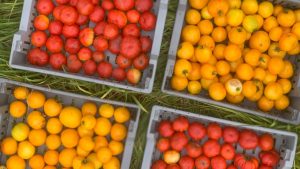
A lot of produce can be dry-farmed, such as these Native Sun and Marmande tomatoes grown near Portland, Ore. Photo by Catherine Nguyen
Dry Farming
by Jordan Anderson
As we continue to see longer drier and hotter summers here in the Willamette Valley, dry farming is a promising approach to mitigating the need to rely upon water throughout the growing season as water shortages loom. A recent article in Science News titled “Dry farming could help agriculture in the western U.S. amid climate change” explored the research behind this farming approach and the larger societal impact it may have on water supply. For dry farming to work a site will require enough rainfall in the winter and spring to create soil moisture levels high enough for young plants to establish. After establishment soil conditions need to exist that allow for moisture to remain accessible to plants throughout the growing season. OSU researchers have been experimenting with different crop varieties and methods for improving the quality and productivity of dry farmed crops. In general dry farmed fruits and vegetables are smaller and produce lower yields per acre. While yields may be lower, many people note that the taste and nutrient density are notably far superior to produce that is irrigated. For this reason it can often be a good fit for CSA market gardens and smaller operations that are focused on quality over quantity. Whatever type of farm you may have, incorporating dry farming into your operation can make your business more resilient and adaptable to the changing climate.


